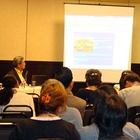In my presentation, I’ll discuss the migration of Japanese-Brazilians to Japan, a process that has led to significant changes in the lives of a growing segment of the Nikkei population in Brazil, as well as in Japan.
Since the early ‘90s, a growing number of Brazilians of Japanese ancestry and their families, with Brazilians descendent from other nationalities, have taken part in the “coming and going” Brazil-Japan route, looking for a better living conditions searching for a dream of technological modernity as reflected in the image of a powerful and rich Japan. That migration stems from the desire to flee Brazil’s economic difficulties while helping to fulfill the needs of Japanese businesses, as the migrants take on unskilled jobs refused by the increasingly better-educated Japanese labors.
In the early stages of the migration, the Brazilian workers displayed a certain homogeneity in regard to their working conditions: they all took on positions deemed “3ks” - kitanai, kitsui, kiken (dirty, heavy, and dangerous) – to which the dekasegi added kirai (detestable) and kibishii (demanding), although nowadays they are working at diverse jobs, including as entrepreuners. In the past, because the physical appearence similarities of both Japanese and Brazilian Nikkei and because the occupation at ”3ks, jobs, Japanese owners lessened the differences in background (educational level, former jobs, social and cultural standing) that the Brazilian migrant workers brought with them to Japan.
Communication barriers due to a lack of knowledge of the Japanese language, values, behavior, and conduct led to problems and challenges to the migrants, who had to work and live in a context radically different from the one to which they were accustomed in Brazil. The labor market and the social establishment – neighborhoods, schools, recreational opportunities – were geared solely to Japanese interests. Today the labor market for Brazilian (and other Latin Americans) include Brazilian businesses ans services.
As their numbers increased, Brazilian workers in Japan lived mainly in areas near businesses that employed Brazilians, such as Oizumi and Ota; Homidanchi in Toyota; and Hamamatsu and Toyohashi. Increasing, the Brazilian population spread out to other regions until they could be found nearly everywhere in Japan.
In my book, Para onde váo os Brasileiros? (Where Brazilians are going to?) , I try to analyze the migrants’ cultural relations and its contradictions regarding their life strategies and their relationships at work, in school, and in their daily lives. These strategies have led the migrants to develop different ways of becoming part of Japanese society, ranging from attempts at “nipponization,” a process that is much valued in Japan, to social segregation and the creation of their own cultural codes within a sociocultural context distinct from the one they left behind in Brazil. In this presentation, I would like to discuss those strategies developed by Brazilians in Japan and their current effects on Brazilian Nikkei living in both countries.
After 20 years of migration, Brazilians in Japan have created a “modus vivendi ” of their own, one that is different from both the Japanese and the Brazilian models. Currently, they gather in certain areas where they can rely on an infrastructure that facilitates their lives in Japan – e.g., Brazilian restaurants, bars, entertainment, goods, movies, music, TV shows, and schools – thus allowing them, in a manner distinct from the past, to live independently from the local customs, Japanese style of living and from the local idiom. In an article titled, “Redes Sociales e Culturales de Migrantes Brasileños en la Ruta Brasil-Japón: Movimiento y Permanencia (Social and Cultural Networks of Brazilian Migrants Along the Brazil-Japan Route: Movement and Settlement)”, I remark that while there is a tendency of groups of Brazilians to remain in Japan, there also takes place a high spatial mobility, whether within Japan or along the route between the two countries. Both processes are made easier because the “Brazilian space” in different regions in Japan – which opens up ways of assisting and connecting with their countrymen – and by formal and informal networks created by the Brazilian migrants themselves. Those networks intensify their interactions whether in Japan or in Brazil.
Although they have created their own social and cultural space, we can’t say that the Brazilians can be categorized as a homogeneous group under the current dekasegi label. Migrants of various Nikkei generations can be found in Japan, in addition to a significant mixed-blood population and their relatives of non-Japanese ancestry. There are successful migrant businesspeople and migrant workers living in difficult financial situations, plus the unemployed and the homeless. Despite the growth of the portion of nouveau riche migrants whose professional activities are geared to the Brazilian consumer goods market, the vast majority of Brazilian workers still rely on the local Japanese labor market, taking on positions rejected by the Japanese. Therefore, in addition to physical and age differences the migrants have distinct social and cultural positions, manifesting in Japan the inequalities so common in Brazilian society.
For the wealthy migrants, social and cultural problems are minimalized by their financial status, especially considering that the successful Brazilian businesspeople hire not only Brazilian but also Japanese workers. This upper social stratum has access to the most sophisticated resources, services, spaces and products found in Japanese society. The issues facing that segment – besides the search for economic competitiveness – are those of communicability and the full social and cultural acceptance of the nouveau riche migrants by Japanese society. The reluctance to accept them is based on the preservation of traditional values and forms of behavior in modern Japanese society, which leads to prejudice and discrimination, even if subtly, when faced with “the other,” the unknown.
For the majority of Brazilian workers in Japan, the most important issues relate to employment, health care, cultural identity, family relations, social communications, and the education of their children. Brazilians in Japan struggle in a relentless search for work, something that makes them subject themselves to frequent uprooting to other cities or regions, which in turn leads to changes in housing and schools, in addition to the continuous need of getting used to new environments. In these situations, numerous children stop going to school – in Japan, the compulsory schooling law applies only to Japanese children – and that leads to other problems tied to vagrancy and to the association of Brazilian children and youth with street gangs.
The Japanese grade and high schools are easily accessible to foreigners. However, because they are not prepared to receive those types of students, especially those from Brazil, the schools have suffered problems related to discrimination, and lack of integration and communication in spite of the growing presence of Brazilian assistants hired to act as cultural liaisons between the school system and the Brazilian students and their parents. By the same token, the growing number of Brazilian schools in Japan keep away numerous children of Brazilian workers because of their high tuition costs, which many Brazilian parents cannot afford. Both types of school present difficulties to the Brazilian population in Japan, whether in terms of content or teaching methods, in addition to the fact that the professional background of the teachers is not always geared to the needs of migrants raised in at least two different cultures and not necessarily ready to take on positions in one single job market in one single society.
The education of their children has not been the chief focus of the Brazilian migrants, whose priority is their job, almost invariably energy-sapping. The education of Brazilian children and youth is either delayed for the return to Brazil or for the return to Japan, and so on. Therefore, the number of Brazilians without formal education keeps growing, creating troubles for their transition to society and to the job market in both countries. The educational challenge for Brazilian children and youth in Japan are depending on their families conditions, in addition to the educational policies of both countries.
The migration has also accelerated changes in family organization and reorganization, according to what is imposed by the job market in Japan. Members of the same family come and go to Japan, and vice-versa, building an mutual assistance network independent from both Japanese and Brazilian governmental policies. Other families are broken apart as a result of new living conditions by migrants in Japan – e.g., new marriages, divorces, diseases and jobs in different places– or by their relatives in Brazil.
Although a segment of the migrant population increasingly strives for permanent residence in Japan – for fear of the “new” and unknown Brazil, following a long absence, or due to one’s identification with Japanese values, security, and way of life – the idea of “being here in passing” still permeates the discourse and actions of a large number of migrants. That context affects their jobs, their family organization, and the education of their children, whose lives are based on the idea of transitoriness. Living life while reminding for the past and having hopes for the future, when dreams will turn into reality, seems to be the most common approach to life among a significant number of migrants.
One particular issue that permeates the lives of all migrants in Japan, regardless of their social status, relates to identity problems: to be perceived as Japanese while in Brazil and as Brazilians or foreigners while in Japan. Who am I? That is the question.
That issue becomes even more complex as a result of both the various social distinctions among the Brazilian migrants and the higher identification of Brazilian children and youth – born or raised in Japan – with the local culture and language, including problems of interaction with their own parents whose cultural roots were acquired in Brazil. Upon their return to Brazil, new identity and adaptation problems emerge for the migrant children and youth .
The process of globalization itself reinforces those identities/mis-identities through cultural influences found in Brazilian society. Japanese modernity has thus been imported through new media-disseminated myths – for instance, sophisticated technologies and manga characters – that are tied to modern Japanese culture. That, in turn, makes the Nikkei identity even more complex, whether or not the Nikkei are migrants.
*The above article is the result of the debate that took place at that event at the round table “Current and historical questions in the Nikkei communities in the Americas,” in which Lili Kawamura took part, along with Célia Sakurai and Akemi Kikumura Yano.
© 2008 Lili Kawamura




